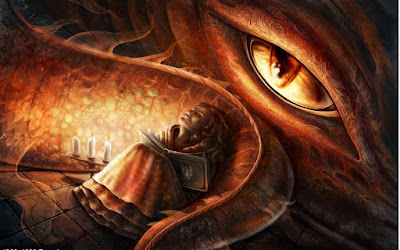 |
| Art from the Pied Piper of Hamelin |
Kate Greenaway was the most popular children’s book illustrator of her generation. During the last two decades of the 19th century, her idyllic illustrations presented an aspirational view of childhood that charmed readers in her native Britain, Europe, and as far away as America. Like her peers Walter Crane and Randolph Caldecott, she collaborated with London’s best color-printer to produce a new, innovative product—high-quality books for the juvenile market. What set Greenaway apart in this triumvirate of excellence was her unique vision. While Crane and Caldecott illustrated stories written for children, Greenaway’s work featured the children themselves—quaintly dressed in ruffles and bonnets and set against picturesque, bucolic landscapes.
 |
| Kate Greenaway in her studio in 1895 |
The enchanted quality of Greenaway’s illustrations reflected her own memorable childhood. She was born in London into a lively, creative family. Her father was a skilled engraver and her mother an inventive milliner. Kate was an imaginative child who absorbed the beauty of the countryside and the intrigue of city life with equal admiration. “Living in that childish wonder is a most beautiful feeling,” she once confided to a friend. “I can so well remember it. There was always something more—behind and above everything—to me; the golden spectacles were very, very big.” Through those golden lenses, Greenaway observed her father’s engaging business. John Greenaway kept a scrapbook of engraving examples, and Kate remembered how a Cruikshank illustration of an execution fascinated and horrified her. Providing an antidote were the half penny fairytales in the family library. Bluebeard and Beauty and the Beast were among her favorites—mysterious, terrifying tales that nonetheless, ended well.
Both parents encouraged Greenaway’s interest in art, and by the time she was twelve, she was winning prizes at a local academy. As her skill increased, she attended London’s South Kensington School and then Heatherley’s, the first British art school to admit women to life-drawing classes. By the age of 21 she was enrolled in London’s newly formed Slade School, an institution dedicated to equal education for women. While still attending classes, Greenaway developed her distinctive style, creating watercolors of children dressed in clothing she designed, assembled and fitted on models or lay figures. Although her costumes resembled the styles of the Regency era, a half-century earlier, they owed as much to invention as to authenticity. When Greenaway finished her education, her drawings found a modest market in the lesser-known periodicals.
A turning point in Kate Greenaway’s career came when a Valentine she designed sold more than 25,000 copies. Her share of the profits was less than three pounds, but the card’s popularity yielded years of work designing birthday and holiday greetings. Although the enterprise provided a modest income, Greenaway’s cards were either unsigned or initialed. Her biographer, M. H. Spielmann, noted that at the age of 33 she was still “the hidden mainspring of a clock with the maker’s name upon the dial.” Greenaway’s fortunes changed in 1878 when she presented a portfolio of 50 drawings with accompanying verses to printer, Edmund Evans. Years later, Evans recalled that first meeting, “I was fascinated with the originality of the drawings and the ideas of the verse, so I at once purchased them and determined to reproduce them in a little volume.” Edmund Evans engraved and printed Greenaway’s “little volume” in 1879. Although the publisher questioned the wisdom of investing in an unknown artist, Evans was in the position to take a risk. By this time, he was operating three thriving establishments built on a decade-long dominance of the juvenile market and an eye for extraordinary talent. Evans issued 20,000 copies of Under the Window, and the initial run sold out before he could release the next 50,000. This triumph began their long, profitable association. Between 1879 and 1898, Evans printed 932,100 works illustrated by Greenaway.
Despite the acclaim accompanying the release of each new Kate Greenaway book, her friends were free with advice on how she could improve her work—mistaking the simplicity of her carefully crafted world for a failure to grasp the principles of academic art. When artist Henry Stacy Marks told her to remove the dark shadows under the heels of her characters, she obeyed. When poet Frederick Locker-Lampson suggested she vary their stoic expressions, she responded politely but changed nothing. When Britain’s leading art critic, John Ruskin, advised her to strip her “girlies” entirely, she did not. “Will you—” Ruskin cajoled. “(It’s all for your own good!)… draw her for me without her hat—and, without her shoes,—(because of the heels) and without her mittens, and without her—frock and its frill?”
Greenaway’s style was the result of a sophisticated, intentional effort to capture the illusive magic of childhood. She was neither naïve nor uninformed. Literature, and contemporary art provided continuing inspiration, and Greenaway was a frequent visitor to London’s museums and galleries. She regularly participated in the city’s cultural life exhibiting her work at the Dudley Gallery, the Royal Academy, the Royal Institute of Painters in Watercolor, and the 1889 International Exhibition in Paris. Her first solo exhibition yielded sales of more than £1,000 and some distinguished patrons—among them painter Sir Frederic Leighton who purchased two of her watercolors.
Refined manners and a cautious reserve disguised Greenaway’s thorough understanding of the worth
 |
| Art from Kate's last book |
The Kate Greenaway Medal was established by The Library Association of the United Kingdom in 1955 for distinguished illustration in a book for children. The award is given annually in the United Kingdom by CILIP, the Chartered Institute of Library and Information Professionals. You can look at a list of the winners of this prestigious award here. Titles that I have loved that won the award include The Lost Words by Jack Morris, This Is Not My Hat by Jon Klassen, Ella's Big Chance by Shirley Hughes, and Mrs. Cockle’s Cat by Antony Maitland.





































